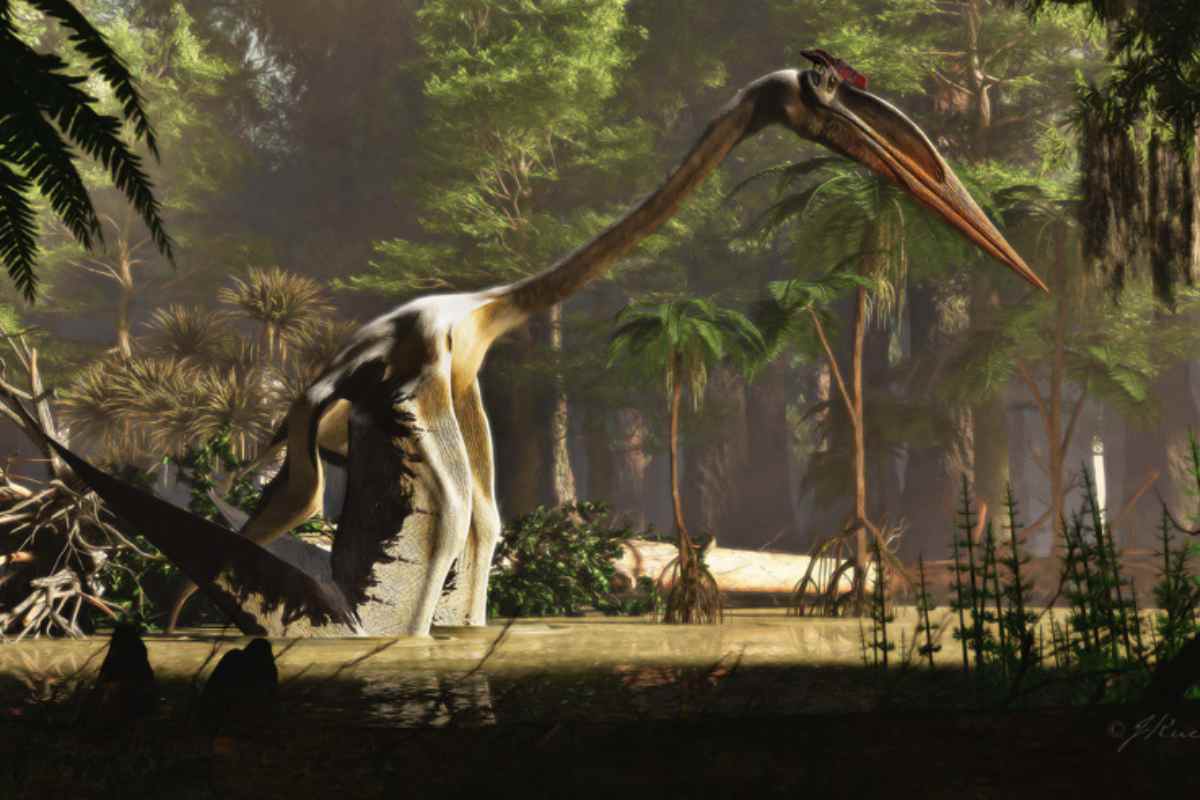
Walking with wings of 6 meters is really not easy…
Today, if you walk through swampy areas, you will see herons up to one meter long wading in shallow water, looking for fish, insects or crustaceans. But about 70 million years ago, you would have seen a more impressive and creepy creature roaming the swamps along Texas’s Rio Grande River. It’s about a pretty terrifying pterosaur known as Quetzalcoatlus. This beast, with a wingspan of nearly 40 feet, was the largest flying animal to ever live on Earth. And in a new study, researchers are now painting the most complete picture of this feared dinosaur relative.
Mystery
In the 1970s, scientists in America’s Big Bend National Park discovered the fossilized bones of the pterosaur. However, one of the mysteries since then has been how an animal with six meters long wings could walk around… The wings should have even touched the ground when folded. In addition, relatively small legs were hidden under its enormous wings. And so the question is how Quetzalcoatlus took to the skies. “This ancient flying reptile is legendary,” said researcher Kevin Padian. “But this is the first time we’re taking a close look at the largest animal that ever flew on Earth.”
Study
The researchers looked at the fossilized bones and compared them with more numerous specimens of a smaller Quetzalcoatlusspecies to better understand flight, walk, and launch behavior. And in the end, the research team succeeded in Quetzalcoatlus to reveal.
wings
The picture the research team ultimately paints is of an animal that resembles modern herons, combined with features of condors and vultures. “Pterosaurs have huge sternums—where the flight muscles attach—so there’s no doubt they were great fliers,” Padian says. “Their humerus — the humerus — features huge, bony crests that anchor the muscles they used to fly. These are larger than those of birds and much larger than those of bats. The wings functioned essentially the same as those of birds and other dinosaurs, to which pterosaurs are most closely related.”
The researchers suspect Quetzalcoatlus had no feathers: its body—including wings—was covered in hair, like all pterosaurs. Like dinosaurs, they were warm-blooded and active. Quetzalcoatlus had no tail, presumably to be more agile. In addition, he looked a bit like an oversized stork. The pterosaur probably had a varied diet and searched the mud for crabs, worms and cockles, but also small fish, insects, snakes and lizards were regularly on its menu.
Like birds, bats, and even humans, the front legs of pterosaurs have three segments: the humerus, the forearm, and the wrist and hand bones. But unlike birds and bats, the outer part of the pterosaur wing consists of a giant “wing finger.” “It’s like a ski pole that extends from the top of your fingers and bends out 90 degrees,” Padian explains.
bipedal
Quetzalcoatlus was bipedal, meaning he walked on two legs. But because the bones of the front legs are so elongated, its wings touched the ground when folded. This led some to suspect that the pterosaurs moved much like a vampire bat; they use their front legs to propel themselves on the ground.

A sketch of the bones of Quetzalcoatlus northropi. The animal had a unique gait, distinctly different from that of a vampire bat. Image: John Conway
However, the researchers are now discovering that Quetzalcoatlus probably couldn’t do this: standing on the ground, he could only move his wings forward or sideways. “Once on the ground, he couldn’t turn his front legs back to move forward,” Padian says. “The bone in his shoulder got in the way.” To advance on the ground, the pterosaur first raised his left arm, then took a step with his left leg and placed his left arm on the ground. He repeated this process on the right. “This may seem a bit cumbersome,” Padian says. “But the animal was able to perform the gait quickly and easily.”
To take off
How Quetzalcoatlus took off? Because its legs were shorter than its wings, it couldn’t simply flap its wings to launch itself. The researchers therefore suspect that the pterosaur used its strong hind legs to jump up. Then, as soon as there was some space beneath him, he began to flap his wings. Herons and egrets do the same, although they are considerably smaller than Quetzalcoatlus.

A step-by-step reconstruction of how Quetzalcoatlus ascended. The pterosaur squats, jumps, and then begins to flap its wings. Image: Kevin Padian and John Conway
The findings are revolutionary for the study of pterosaurs — the first animals, after insects, to ever develop powered flight. Padian admits there are still some questions about it Quetzalcoatlus and pterosaurs in general remain unanswered. But thanks to the extensive research, we now have a much better picture of how the largest flying animal that ever lived on Earth moved – in a rather peculiar way.
Source material:
“Fleshing out the bones of Quetzalcoatlus, Earth’s largest flier ever” – University of Berkeley
Image at the top of this article: James Kuether